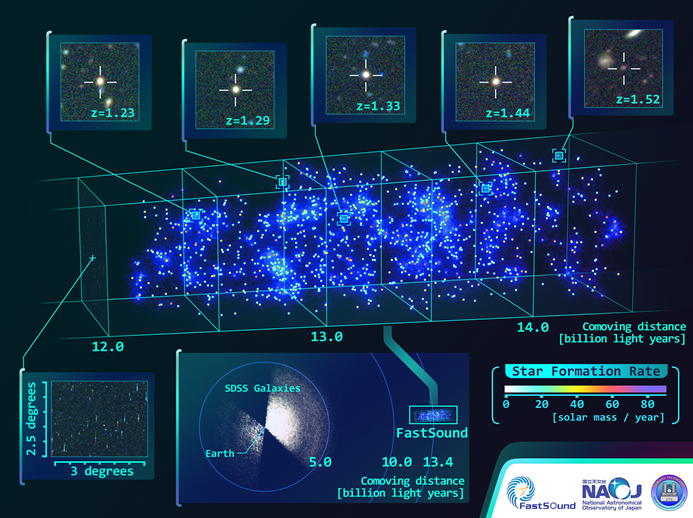|
Images and Movies
- high resolution file of the following image (png, 5.1 MB)
- movie of the 3D map (wmv, 82.2 MB)

Figure Caption:
The FastSound project's 3D map of the large-scale structure
of a region in the Universe about 4.7 billion years after the Big Bang.
This area covers 2.5 times 3 degrees of the sky, with
a radial distance spanning 12-14.5 billion light years in comoving distance or 8-9.6 billion light years in light travel distance (see note below).
This is about a quarter of the final volume size of FastSound.
The colors of the galaxies indicate their star formation rate, i.e., the total mass of stars produced in a galaxy every year. The gradation in background color represents the number density
of galaxies; the distribution of dark matter would look like this if we can see it.
(It is believed that dark matter exists in the universe in a similar distribution to galaxies, but its density
is about 10 times higher than galaxies. The large scale structure of the universe forms by the gravity of dark matter.)
The lower part of the figure shows the relative locations of the FastSound and the Sloan Digital Sky Survey (SDSS) regions, indicating that the FastSound project is mapping a more distant Universe than SDSS’s 3D map of the nearby Universe.
Note on distance
The expansion of the Universe gives rise to different definitions of what distance means. The 3D map shown in this release uses a measure of comoving distance rather than light travel distance. Light travel distance refers to the time that has elapsed from the epoch of the observed distant galaxy to the present, multiplied by the speed of light. Since the speed of light is always constant for any observer, it describes the distance of the path that a photon has traveled. However, the expansion of the Universe increases the length of the path that the photon traveled in the past. Comoving distance, the geometrical distance in the current Universe, takes this effect into account. Therefore, comoving distance is always larger than the corresponding light travel distance.
|
 Welcome to the Home Page of the FastSound Project. 日本語解説ページ
Welcome to the Home Page of the FastSound Project. 日本語解説ページ Welcome to the Home Page of the FastSound Project. 日本語解説ページ
Welcome to the Home Page of the FastSound Project. 日本語解説ページ